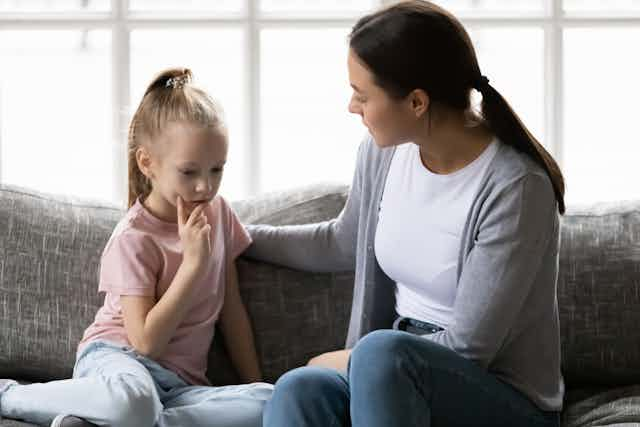A recent report from the charity YoungMinds found that over 1.2 million children and young people aged 18 and under were referred to mental health services in England in 2022. This is more than double the number in 2019.
When the number of young people needing help is so great, services become overstretched and there are enormous challenges in providing timely support.
Our research has explored ways of getting help to more children more quickly. We focused on children with anxiety problems because they are extremely common, often first occur in childhood and their negative impact can persist into adulthood.
We looked at how effective it would be for parents to apply cognitive behavioural therapy (CBT) strategies with their child, learning how to do so by using an online platform with phone support from a therapist. We found that this parent-led CBT had the same results for children as routine (mostly CBT) treatment, while also saving costs by substantially reducing therapists’ treatment delivery time.
Read more: The impact of childhood and teenage anxiety disorders on later life – new research
Finding time
CBT is an effective talking therapy for child anxiety disorders. Children are helped to develop new ways of thinking by testing out their fears in a supported way. A traditional CBT course involves ten to 20 hours of time with a therapist, which can create a real challenge both for busy services and busy families.
In our approach, a therapist supports a parent, who then applies CBT skills and strategies in their child’s daily life. This requires less contact time with a therapist than traditional forms of CBT.
We’ve developed an online platform to help parents apply CBT strategies with their child, with remote therapist support. The platform features a parent portal where parents or carers work through seven online modules. Parents are encouraged to have a go at the strategies that they learn through the modules with their child.

They then have a weekly call, of about 20 minutes, with a therapist after each module. During these telephone appointments, the therapist helps them to plan how best to apply the approach with their child and to address any problems they may have encountered.
To make the treatment easy to understand and accessible, modules provide content in a range of formats, such as text, videos and quizzes. Information is shared with the therapist, who can view progress via a clinician portal.
We carried out a study with 444 families to find out whether this approach means support can be delivered more quickly to more children than current NHS treatment approaches – while continuing to achieve good outcomes.
This began in March 2020, when the first COVID lockdown started in the UK. There was an immediate and sudden need for remotely delivered interventions, together with an increased need for mental health support.
Working with families
The families we invited to join our study had children aged from five to 12 years who were experiencing anxiety problems, and had approached either NHS child and adolescent mental health services, local authorities, or charities for help.
Half of the children and their families were randomly assigned to receive our online treatment. The rest were assigned the traditional treatment offered by the mental health services that they approached for help.
We asked parents to complete a series of online questionnaires to know how they and their children were doing during the treatment period, and up to 26 weeks after they started the trial. The questionnaires included clinical measures, including measures of anxiety problems and quality of life.
They also asked about other things, such as whether the child or parent used other health care services beyond the treatment for child anxiety problems. The children themselves filled in some questionnaires too.
We found that clinical treatment results were very similar for both the new online and the routine treatment. Both performed equally well in terms of measures such as whether child anxiety problems interfered with school, social, and family life; whether anxiety symptoms reduced; and whether the child had other emotional and behavioural problems that commonly occur alongside anxiety.
However, the average time that the therapists spent delivering the treatment was substantially lower for our online approach (182 minutes) than for routine treatment (307 minutes). This frees up therapist time – meaning more children could be treated more quickly.
Parents and clinicians also told us that they found the online platform easy to use and the approach overcome many potential barriers to accessing mental health support for children.
We also conducted an economic evaluation to compare the health and the cost impacts of this approach and routine NHS treatments, and found that the online approach was likely to be good value for money.
In other words, helping parents to apply CBT strategies with their child, using the online platform with therapist support, brought about promising savings, without compromising outcomes for child anxiety problems.

